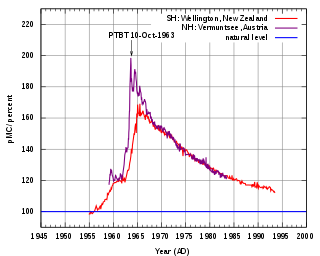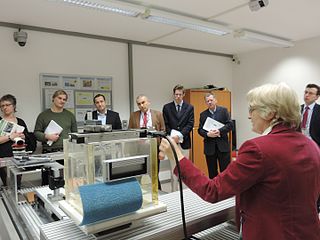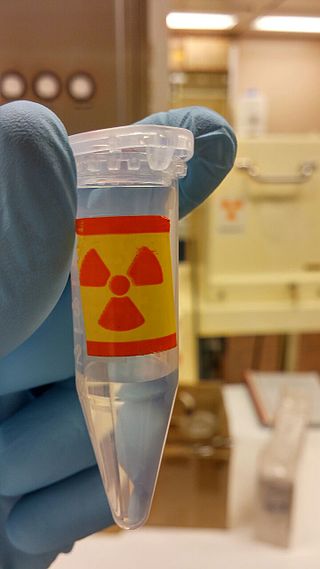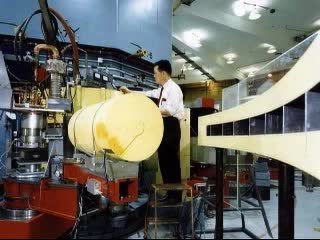Related Research Articles
Background radiation is a measure of the level of ionizing radiation present in the environment at a particular location which is not due to deliberate introduction of radiation sources.

Nuclear fallout is residual radioactive material propelled into the upper atmosphere following a nuclear blast, so called because it "falls out" of the sky after the explosion and the shock wave has passed. It commonly refers to the radioactive dust and ash created when a nuclear weapon explodes. The amount and spread of fallout is a product of the size of the weapon and the altitude at which it is detonated. Fallout may get entrained with the products of a pyrocumulus cloud and when combined with precipitation falls as black rain, which occurred within 30–40 minutes of the atomic bombings of Hiroshima and Nagasaki. This radioactive dust, usually consisting of fission products mixed with bystanding atoms that are neutron-activated by exposure, is a form of radioactive contamination.

Acute radiation syndrome (ARS), also known as radiation sickness or radiation poisoning, is a collection of health effects that are caused by being exposed to high amounts of ionizing radiation in a short period of time. Symptoms can start within an hour of exposure, and can last for several months. Early symptoms are usually nausea, vomiting and loss of appetite. In the following hours or weeks, initial symptoms may appear to improve, before the development of additional symptoms, after which either recovery or death follow.
The Occupational Safety and Health Administration is a regulatory agency of the United States Department of Labor that originally had federal visitorial powers to inspect and examine workplaces. The United States Congress established the agency under the Occupational Safety and Health Act, which President Richard M. Nixon signed into law on December 29, 1970. OSHA's mission is to "assure safe and healthy working conditions for working men and women by setting and enforcing standards and by providing training, outreach, education, and assistance." The agency is also charged with enforcing a variety of whistleblower statutes and regulations. OSHA's workplace safety inspections have been shown to reduce injury rates and injury costs without adverse effects on employment, sales, credit ratings, or firm survival.

Radiation dosimetry in the fields of health physics and radiation protection is the measurement, calculation and assessment of the ionizing radiation dose absorbed by an object, usually the human body. This applies both internally, due to ingested or inhaled radioactive substances, or externally due to irradiation by sources of radiation.
Radiation protection, also known as radiological protection, is defined by the International Atomic Energy Agency (IAEA) as "The protection of people from harmful effects of exposure to ionizing radiation, and the means for achieving this". Exposure can be from a source of radiation external to the human body or due to internal irradiation caused by the ingestion of radioactive contamination.

Health physics, also referred to as the science of radiation protection, is the profession devoted to protecting people and their environment from potential radiation hazards, while making it possible to enjoy the beneficial uses of radiation. Health physicists normally require a four-year bachelor’s degree and qualifying experience that demonstrates a professional knowledge of the theory and application of radiation protection principles and closely related sciences. Health physicists principally work at facilities where radionuclides or other sources of ionizing radiation are used or produced; these include research, industry, education, medical facilities, nuclear power, military, environmental protection, enforcement of government regulations, and decontamination and decommissioning—the combination of education and experience for health physicists depends on the specific field in which the health physicist is engaged.

Radioactive contamination, also called radiological pollution, is the deposition of, or presence of radioactive substances on surfaces or within solids, liquids, or gases, where their presence is unintended or undesirable.

The linear no-threshold model (LNT) is a dose-response model used in radiation protection to estimate stochastic health effects such as radiation-induced cancer, genetic mutations and teratogenic effects on the human body due to exposure to ionizing radiation. The model assumes a linear relationship between dose and health effects, even for very low doses where biological effects are more difficult to observe. The LNT model implies that all exposure to ionizing radiation is harmful, regardless of how low the dose is, and that the effect is cumulative over lifetime.
The threshold limit value (TLV) is a level of occupational exposure to a hazardous substance where it is believed that nearly all healthy workers can repeatedly experience at or below this level of exposure without adverse effects. Strictly speaking, TLV is a reserved term of the American Conference of Governmental Industrial Hygienists (ACGIH), who determines and publishes TLVs annually. TLVs issued by the ACGIH are the most widely accepted occupational exposure limits both in the United States and most other countries. However, it is sometimes loosely used to refer to other similar concepts used in occupational health and toxicology, such as acceptable daily intake (ADI) and tolerable daily intake (TDI). Concepts such as TLV, ADI, and TDI can be compared to the no-observed-adverse-effect level (NOAEL) in animal testing, but whereas a NOAEL can be established experimentally during a short period, TLV, ADI, and TDI apply to human beings over a lifetime and thus are harder to test empirically and are usually set at lower levels. TLVs, along with biological exposure indices (BEIs), are published annually by the ACGIH.

Nuclear pharmacy, also known as radiopharmacy, involves preparation of radioactive materials for patient administration that will be used to diagnose and treat specific diseases in nuclear medicine. It generally involves the practice of combining a radionuclide tracer with a pharmaceutical component that determines the biological localization in the patient. Radiopharmaceuticals are generally not designed to have a therapeutic effect themselves, but there is a risk to staff from radiation exposure and to patients from possible contamination in production. Due to these intersecting risks, nuclear pharmacy is a heavily regulated field. The majority of diagnostic nuclear medicine investigations are performed using technetium-99m.
Right to know is a human right enshrined in law in several countries. UNESCO defines it as the right for people to "participate in an informed way in decisions that affect them, while also holding governments and others accountable". It pursues universal access to information as essential foundation of inclusive knowledge societies. It is often defined in the context of the right for people to know about their potential exposure to environmental conditions or substances that may cause illness or injury, but it can also refer more generally to freedom of information or informed consent.

The Atomic Energy Regulatory Board (AERB) was constituted on 15 November 1983 by the President of India by exercising the powers conferred by Section 27 of the Atomic Energy Act, 1962 to carry out certain regulatory and safety functions under the Act. The regulatory authority of AERB is derived from the rules and notifications promulgated under the Atomic Energy Act, 1962 and the Environmental (Protection) Act, 1986. The headquarters is in Mumbai.
Bioenvironmental Engineers (BEEs) within the United States Air Force (USAF) blend the understanding of fundamental engineering principles with a broad preventive medicine mission to identify, evaluate and recommend controls for hazards that could harm USAF Airmen, employees, and their families. The information from these evaluations help BEEs design control measures and make recommendations that prevent illness and injury across multiple specialty areas, to include: Occupational Health, Environmental Health, Radiation Safety, and Emergency Response. BEEs are provided both initial and advanced instruction at the United States Air Force School of Aerospace Medicine at Wright-Patterson Air Force Base in Dayton, Ohio.

Nuclear Power and the Environment, sometimes simply called the Flowers Report, was released in September 1976 and is the sixth report of the UK Royal Commission on Environmental Pollution, chaired by Sir Brian Flowers. The report was dedicated to "the Queen's most excellent Majesty." "He was appointed "to advise on matters, both national and international, concerning the pollution of the environment; on the adequacy of research in this field; and the future possibilities of danger to the environment." One of the recommendations of the report was that:
"There should be no commitment to a large programme of nuclear fission power until it has been demonstrated beyond reasonable doubt that a method exists to ensure the safe containment of longlived, highly radioactive waste for the indefinite future."

Radiation dose reconstruction refers to the process of estimating radiation doses that were received by individuals or populations in the past as a result of particular exposure situations of concern. The basic principle of radiation dose reconstruction is to characterize the radiation environment to which individuals have been exposed using available information. In cases where radiation exposures can not be fully characterized based on available data, default values based on reasonable scientific assumptions can be used as substitutes. The extent to which the default values are used depends on the purpose of the reconstruction(s) being undertaken.
The Australian Radiation Protection and Nuclear Safety Agency (ARPANSA) is a regulatory agency under the Commonwealth of Australia that aims to protect Australian citizens from both ionising and non-ionising radiation. ARPANSA works under the guidance of the Australian Radiation Protection and Nuclear Safety Act of 1998 as the national regulatory body of radiation in Australia, with independent departments within each state and territory that regulate radiation within each of their jurisdictions.
The committed dose in radiological protection is a measure of the stochastic health risk due to an intake of radioactive material into the human body. Stochastic in this context is defined as the probability of cancer induction and genetic damage, due to low levels of radiation. The SI unit of measure is the sievert.
Exposure to ionizing radiation is known to increase the future incidence of cancer, particularly leukemia. The mechanism by which this occurs is well understood, but quantitative models predicting the level of risk remain controversial. The most widely accepted model posits that the incidence of cancers due to ionizing radiation increases linearly with effective radiation dose at a rate of 5.5% per sievert; if correct, natural background radiation is the most hazardous source of radiation to general public health, followed by medical imaging as a close second. Additionally, the vast majority of non-invasive cancers are non-melanoma skin cancers caused by ultraviolet radiation. Non-ionizing radio frequency radiation from mobile phones, electric power transmission, and other similar sources have been investigated as a possible carcinogen by the WHO's International Agency for Research on Cancer, but to date, no evidence of this has been observed.

Nuclear labor issues exist within the international nuclear power industry and the nuclear weapons production sector worldwide, impacting upon the lives and health of laborers, itinerant workers and their families.
References
- ↑ "Subpart B—General Administrative Requirements". Nuclear Regulatory Commission. 16 January 2019. Retrieved 2024-11-06.